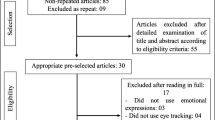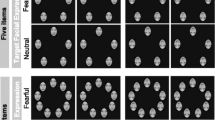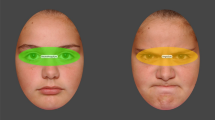Abstract
The hypervigilance-avoidance hypothesis assumes that anxious individuals initially attend to and subsequently avoid threatening stimuli. In this study pairs of emotional (angry or happy) and neutral facial expressions were presented to students of high or low fear of negative evaluation (FNE) while their eye movements were recorded. High FNE participants initially looked more often at emotional compared to neutral faces, indicating an attentional bias for emotional facial expressions. This effect was further modulated by the sex of the face, as high FNE clearly showed a preference for happy female faces. Analysis of the time course of attention revealed that high FNE looked at the emotional faces longer during the first second of stimulus exposure, whereas they avoided these faces in the consecutive time interval from 1 to 1.5 s. These results partially support the hypervigilance-avoidance hypothesis and additionally indicate the relevance of happy faces for high FNE. Further research should clarify the meaning of happy facial expressions as well as the influence of the sex of the observed face in social anxiety.


Similar content being viewed by others

Notes
As the low FNE group was significantly older than the high FNE group, all the analyses of eye movement data were repeated using age as a covariate. The findings from analyses of covariance (ANCOVAs) corroborated those from the ANOVAs by showing the same significant effects and interactions.
References
Bögels SM, Mansell W (2004) Attention processes in the maintenance and treatment of social phobia: hypervigilance, avoidance and self-focused attention. Clin Psychol Rev 24:827–856
Bradley BP, Mogg K, Millar NH (2000) Covert and overt orienting of attention to emotional faces in anxiety. Cogn Emot 14:789–808
Chen YP, Ehlers A, Clark DM et al (2002) Patients with generalized social phobia direct their attention away from faces. Behav Res Ther 40:677–687
Clark DM, Wells A (1995) A cognitive model of social phobia. In: Heimberg RG et al (ed) Social phobia: diagnosis, assessment, and treatment. Guilford Press, New York, pp 69–93
Corden B, Chilvers R, Skuse D (2008) Avoidance of emotionally arousing stimuli predicts social-perceptual impairment in asperger’s syndrome. Neuropsychologia 46:137–147
Dimberg U (1997) Social fear and expressive reactions to social stimuli. Scand J Psychol 38:171–174
Esteves F (1999) Attentional bias to emotional facial expressions. Eur Rev Appl Psychol 49:91–97
Findlay JM, Gilchrist ID (2003) Active vision: the psychology of looking and seeing. Oxford University Press, Oxford
Fydrich T (2002) Spai—Soziale Phobie und Angst Inventar. In: Brähler E, Schumacher J, Strauß B (eds) Diagnostische Verfahren in der Psychotherapie. Hogrefe, Göttingen
Garner M, Mogg K, Bradley BP (2006) Orienting and maintenance of gaze to facial expressions in social anxiety. J Abnorm Psychol 115:760–770
Gilboa Schechtman E, Foa EB, Amir N (1999) Attentional biases for facial expressions in social phobia: the face-in-the-crowd paradigm. Cogn Emot 13:305–318
Horley K, Williams LM, Gonsalvez C et al (2003) Social phobics do not see eye to eye: a visual scanpath study of emotional expression processing. J Anxiety Disord 17:33–44
Koster EHW, Crombez G, Verschuere B et al (2004) Selective attention to threat in the dot probe paradigm: differentiating vigilance and difficulty to disengage. Behav Res Ther 42:1183–1192
Laux L, Glanzmann P, Schaffner P et al (1981) Das State-Trait-Angstinventar. Weinheim: Beltz Test
Leary MR (1983) A brief version of the fear of negative evaluation scale. Pers Soc Psychol Bull 9:371–375
Mansell W, Clark DM, Ehlers A et al (1999) Social anxiety and attention away from emotional faces. Cogn Emot 13:673–690
Mogg K, Bradley BP (1998) A cognitive-motivational analysis of anxiety. Behav Res Ther 36:809–848
Mogg K, Bradley BP, De Bono J et al (1997) Time course of attentional bias for threat information in non-clinical anxiety. Behav Res Ther 35:297–303
Mogg K, Millar N, Bradley BP (2000) Biases in eye movements to threatening facial expressions in generalized anxiety disorder and depressive disorder. J Abnorm Psychol 109:695–704
Mogg K, Bradley BP, Miles F et al (2004a) Time course of attentional bias for threat scenes: testing the vigilance-avoidance hypothesis. Cogn Emot 18:689–700
Mogg K, Philippot P, Bradley BP (2004b) Selective attention to angry faces in clinical social phobia. J Abnorm Psychol 113:160–165
Perowne S, Mansell W (2002) Social anxiety, self-focused attention, and the discrimination of negative, neutral and positive audience members by their non-verbal behaviours. Behav Cogn Psychother 30:11–23
Pflugshaupt T, Mosimann UP, von Wartburg R et al (2005) Hypervigilance-avoidance pattern in spider phobia. J Anx Disord 19:105–116
Pishyar R, Harris LM, Menzies RG (2004) Attentional bias for words and faces in social anxiety. Anxiety Stress Coping 17:23–36
Rodebaugh TL, Woods CM, Thissen DM et al (2004) More information from fewer questions: the factor structure and item properties of the original and brief fear of negative evaluation scale. Psychological Assessment 16
Spector I, Pecknold JC, Libman E (2003) Selective attentional bias related to the noticeability aspect of anxiety symptoms in generalized social phobia. J Anx Disord 17:517–531
Spencer-Smith J, Wild H, Innes-Ker AH et al (2001) Making faces: creating three-dimensional parameterized models of facial expression. Behav Res Methods Instrum Comput 33:115–123
Spielberger CD, Gorsuch RL, Lushene RE (1970) State-trait anxiety inventory. Consulting Psychologists Press, Palo Alto
Turner SM, Beidel DC, Dancu CV et al (1989) An empirically derived inventory to measure social fears and anxiety: the social phobia and anxiety inventory (spai). Psychol Assess 1:35–40
Vormbrock F, Neuser J (1983) Konstruktion zweier spezifischer trait-Fragebogen zur Erfassung von Angst in sozialen Situationen (SANB und SVSS); construction of two specific trait-oriented questionnaires for the assessment of anxiety in social situations (SANB und SVSS). Diagnostica 29:165–182
Watson D, Friend R (1969) Measurement of social-evaluative anxiety. J Consult Clin Psychol 33:448–457
Weyers P, Mühlberger A, Hefele C et al (2006) Electromyographic responses to static and dynamic avatar emotional facial expressions. Psychophysiology 43:450–453
Wieser MJ, Pauli P, Alpers GW et al (2008) Is eye to eye contact really threatening and avoided in social anxiety?—An eye-tracking and psychophysiology study. J Anx Disord. doi:10.1016/j.janxdis.2008.04.004
Acknowledgment
We thank Mathias Müller for technical assistance. This work was supported by the grant MU2299-1/2 by the Deutsche Forschungsgemeinschaft (DFG).
Author information
Authors and Affiliations
Corresponding author
Rights and permissions
About this article
Cite this article
Wieser, M.J., Pauli, P., Weyers, P. et al. Fear of negative evaluation and the hypervigilance-avoidance hypothesis: an eye-tracking study. J Neural Transm 116, 717–723 (2009). https://doi.org/10.1007/s00702-008-0101-0
Received:
Accepted:
Published:
Issue Date:
DOI: https://doi.org/10.1007/s00702-008-0101-0



